Unidata specialises in the design, manufacture, supply and support of products and solutions for environmental monitoring and industrial measurement. Products and systems range from acquisition devices, to standalone and IP (Ethernet, cellular and satellite) connected loggers, through to web-based logging and analysis tools. The extensive range of products is most typically available ex-stock to ensure a fast turnaround on orders. Unidata products can be configured to provide solutions for most environmental monitoring and industrial measurement requirements. Unidata and its partners pride themselves on finding solutions to their customers’ requirements and so they are always pleased to discuss specific requirements and how Unidata products can meet them.
Please note that after many years of hard working and reliable service Starlog Range of Loggers (Starlogger, Prologger and Micrologger) is now superseded by new generation Neon Remote Logger Range. New Neon Remote Loggers have option of working in Starlog emulation mode making transition from old Starlog Logger to new Neon Remote Logger stress-free. From now on, if you are looking for Starlog functionalities please refer to new NRL models: Starlogger 6004D-1 and 6004D-2 are superseded by NRL 3008-000, Prologger 7001D-1 is superseded by 3016-000 and Micrologger 8010C by 3004-M000.
We will continue to provide the normal service and support for the Starlog range. Starlog Product Manuals are available at Support Product Manuals page.
Application Notes
Should you have any questions at all about the products or their application and use, please don’t hesitate to Contact Unidata or one of it’s partners.
Unidata’s Starflow QSD Velocity, Depth and Temperature 6527 is ideal for smaller open channel and pipe measurements as it is a complete hydrographic data collection system. It operates in a wide range of water qualities from fresh streams to primary sewerage channels. It measures both forward and reverse flows, and is particularly useful at sites where a stable stage/ velocity relationship does not exist.
Starflow QSD measures water velocity, depth, flow and temperature, enabling you to do a complete stream study with a single instrument. For very small flow monitoring the Unidata tipping bucket flow gauge can be used 6506G/H.
Open channels, partly filled pipes, and natural streams have very complex velocity characteristics. Turbulence, waves, stream slope, bed and wall unevenness, rocks and debris, all combine to create an unpredictable velocity profile.
To account for these effects Starflow QSD analyses up to one thousand separate velocity measurements and statistically determines the mean velocity. This approach provides a good “average velocity” even under difficult conditions.
The Starlog V4 companion software allows a user to define the stream, channel or pipe profile, so that the velocity and depth readings can be converted to a true flow reading.
It will acquire instantaneous, maximum, minimum and average readings. Starflow QSD is equipped with the SDI-12 or MODBUS communications facility, a backup lithium battery, and an interface to a telemetry system, such as Neon. By connecting a rain gauge 6506C you can make a complete stormwater monitoring system.
There are several different methods used to measure water level.
The measurement methods include:
1 – a still well or still pipe with a shaft encoder/float and wheel/beaded float line system
2 – a pressure sensor that is immersed in the stream or river
3 – the more complex pressure bubbler system that allows for a small open tube to be immersed into the stream or river with a gas pump or gas cylinder to inject small bubbles into the open tube and measure water depth by measuring the back pressure required to force bubbles out of the tube in the water
There are also emerging technologies such as radar and ultrasonic which can be used to measure water depth.
While there are many methods/technologies available, the most common and the most stable method is the shaft encoder float and wheel system. This method required a large well or a smaller pipe to be installed on the stream or river bank or on a bridge structure to provide a stable / not disturbed by flow or wind measurement environment for a small float, a float-line and a counterweight so the movement in stream/river level can be measured by the rotation of the shaft of a wheel. Typically the shaft rotation is measured very accurately by light or laser encoder, and the data is shown on the display and is recorded in the data logger within the instrument.
The Unidata 6541D Precision Water Level Instrument is a very accurate shaft encoder instrument, which has an LED display for the water level, as well as an internal data logger so water level readings can be recorded every 1, 5 or 10 minutes as required. When a Neon Remote Terminal or Module is added, the water level information can be transmitted over the internet to a central Neon server to allow authorities to view the data on the web in near real-time.
Surface water monitoring equipment measures surface water quality and quantity and transmit the information via cell phone or satellite to a central Neon server where it can be analysed to make meaningful water management decisions.
Such systems may include instruments to measure water flow and water quality for example 6537, water depth 6548A and 6549A, and pH 6528C in small open channels and stormwater drains and channels.
Surface water movement may also be monitored into and out of small dams and ponds in agricultural areas. For large pipes and small open channels, ultrasonic velocity and depth meters can be used to measure occasional flows (during rain periods for example) and also test the water quality of such occasional flows.
Groundwater depth is measured with a small diameter sensor deep in an observation borehole. Water depth can be measured with a pressure sensor lowered down the borehole and immersed in the water 6549D. This is called the hydrostatic depth method. Alternatively a standard float-and-pulley sensor system with a small float and a pulley at the top of the borehole can also be used to measure depth 6541D.
The hydrostatic depth method is widely used as it is convenient to install, however, all pressure sensors have some drift which needs to be considered. The float and pulley method is less convenient, especially in narrow diameter boreholes of 100mm, but it is very accurate and is not subject to drift.
A Neon IP Data Logger/RTU/NRT needs to be added at the top of the bore and data recorded and collected manually, or the data can be telemetered to a central location on a regular, perhaps 4 hourly basis.
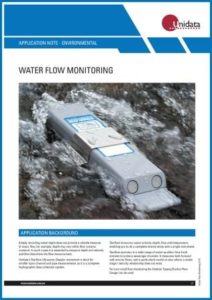
WATER FLOW MONITORING
Simply recording water depth does not provide a reliable measure of water flow, for example, depth may vary while flow remains constant. In such cases it is essential to measure depth and velocity and then determine the flow measurement.
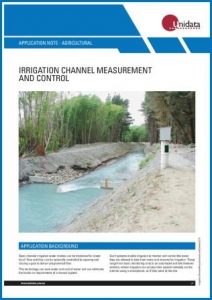
IRRIGATION CHANNEL MEASUREMENT
Open-channel irrigation water intakes can be monitored for water level / flow and they can be optionally controlled by opening and closing a gate to deliver programmed flow.
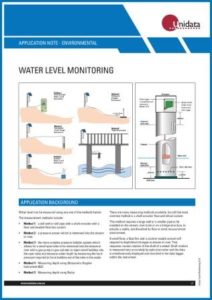
WATER LEVEL MONITORING
While there are many methods / technologies available, the most common and the most stable method is the shaft encoder float and wheel system

EVAPORATION MONITORING
The rate of evaporation is defined as the amount of water evaporated from a unit surface area per unit of time. This parameter is an important indicator of the need for water of agricultural areas and also for hydrologists to monitor the water balance of an area.
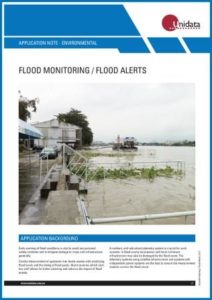
FLOOD MONITORING
Early warning of flood conditions is vital to avoid any personal safety incidents and to mitigate damage to crops and infrastructure generally.
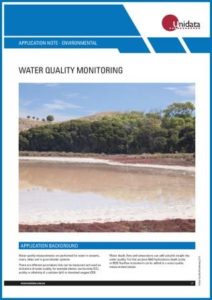 WATER QUALITY MONITORING
WATER QUALITY MONITORING
Water quality measurements are performed for water in streams, rivers, lakes and in the groundwater system, using boreholes.